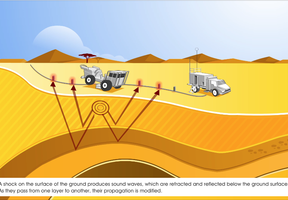A Brief History of Oil Prices
5 min read
Oil prices have fluctuated considerably over the decades, particularly during the global crises of 1973, 1979 and 2008 and following the economic developments of 2014 and 2015. The price of crude has a significant impact on the global economy due to the dominant role this resource plays, both today and in the decades to come.

© PASCAL LAURENT / TotalEnergies - Oil storage tanks in Ho Chi Minh City, Vietnam
The price of a of has for decades been as much a geopolitical metric as an economic one. It continues to be calculated based on a unit of measurement dating from the 19th century, i.e. the barrel (corresponding to about 159 liters), even though oil is now transported in bulk via pipelines, tankers and trains.
In fact, it is more accurate to talk about oil prices in the plural. This is because the prices set in the global markets, primarily in New York and London, are based on different benchmark or marker crude oils, especially (North Sea crude) for Europe and West Texas Intermediate (WTI) for North America. These oils are each governed by their own laws of supply and demand, which means that their prices may evolve differently.
The First Oil Crises
From 1860 to 1940, oil prices fluctuated in response to international events, rising during the First World War and falling during the Great Depression. From 1948 to 1970, they remained relatively low and stable until they were shaken by a series of oil crises or "oil shocks".
The first oil crisis got started in 1971 when the Bretton Woods international monetary system was abandoned. It intensified in 1973 during the Yom Kippur War, when Arab oil-producing nations placed an embargo on oil shipments to countries that supported Israel. Oil prices quadrupled within a year.
The Iranian revolution in 1978 and the Iran-Iraq war in 1980 triggered the second oil crisis, which led oil prices to double.
2008 Price Volatility
The third oil crisis began in 2003 when growing demand from China, India, Brazil and other emerging economies set in motion an upward price trend that accelerated suddenly in the first half of 2008 at the time of the global economic crisis. The price of Brent soared from $96 per barrel on January 2, 2008 to $144 on July 3, 2008. The repercussions on prices were less dramatic.
Oil prices then took a major tumble at the peak of the financial crisis. The monthly average crude oil price slid from $130 per barrel in July to $40 per barrel in December 2008. Starting in 2009, as oil-producing countries began reducing output to maintain their revenue levels, the average gradually climbed back up to $80.
In 2010, the economic recovery brought with it the strongest growth in oil demand observed since 2004. This helped to drive prices up again. They climbed further in early 2011 in the wake of the Arab Spring uprisings, with the markets fearing potential negative impacts on production capacity. On March 13, 2012, the price of Brent reached a new high of $128, before stabilizing at more than $100 in 20131.
The 2014-2015 Oil Price Decline and 2016 Recovery
Oil prices collapsed in the summer of 2014, falling below $50 per barrel at the beginning of 2015 despite rising world demand. The primary cause was excess supply, driven by production in the United States. Saudi Arabia decided to defend its market share by maintaining OPEC's production levels in the hope of forcing U.S. producers to reduce their output, creating a standoff. The price of Brent slipped below $30 a barrel in January 2016 to levels not seen since 2003, creating serious trouble for some oil-producing nations such as Venezuela, Algeria and Russia.
Oil prices began to recover in February 2016, reaching $50 per barrel in June 2016, primarily due to the decision of Saudi Arabia, Venezuela, Qatar and Russia to freeze production. But uncertainties still remained in mid-2016.
The general trend toward lower prices has significantly undermined investment, which could threaten the availability of oil over the coming years and lead to an upward spiral in oil prices.
2020: The Global Covid-19 Crisis
The Covid-19 pandemic caused further major disruption by triggering a steep decline in global economic growth and a virtual shutdown of the tourism industry, beginning in March 2020. At the height of the crisis at end-April 2020, the price of Brent crude plunged from $50 a barrel to a 20-year low of less than $20. In June, prices began making their way back to the $40-45 range. According to World Bank estimates, global gross domestic product (GDP) contracted by more than 5% in 2020, which would represent the worst worldwide recession since the Second World War.
Uncertainty over the global pandemic and its impacts makes forecasting very difficult. Nevertheless, in an October 2020 report, the drew up a scenario showing a return of oil demand to pre-crisis levels by 2023.






















